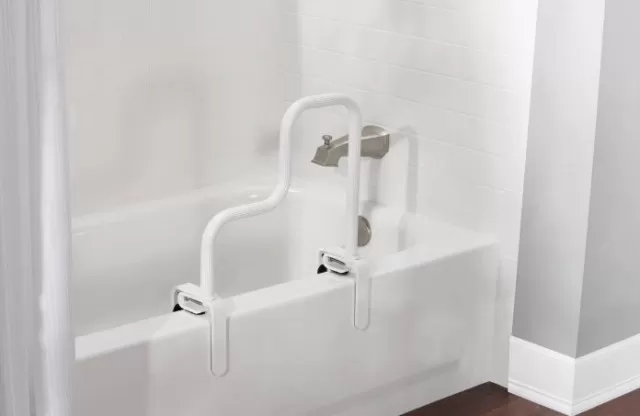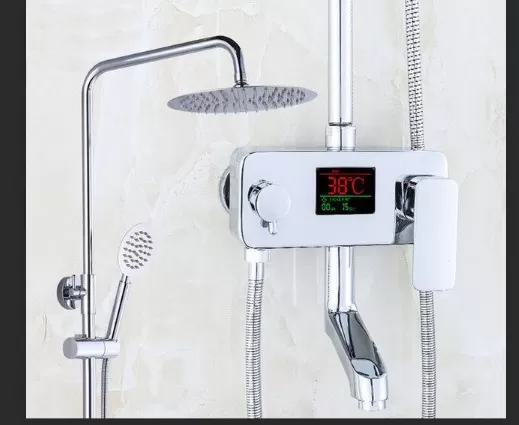Enhance Bathroom Safety: Practical Ways to Make it Safer. When it comes to bathroom safety, prevention is paramount. The risk of bathroom injuries tends to increase with age, but it’s essential to implement precautions early on.
By following these tips, you can create a safer bathroom environment for everyone in your household Remember, bathroom safety is essential for individuals of all ages. By taking preventive measures and creating a safer bathroom environment, you can reduce the risk of accidents and promote well-being for everyone in your household.
Enhancing Bathroom Safety: A Priority for All Ages

While prioritizing bathroom safety is crucial for seniors, it is equally vital for individuals of all age groups, as accidents can occur unexpectedly.
Shockingly, every year, approximately 43,000 children end up in the emergency room due to slip-and-fall incidents, hot-water scalds, and other unfortunate bathroom mishaps. Such statistics emphasize the necessity of taking proactive measures to ensure a secure and functional bathroom environment.
Considering that we devote up to an hour each day in this space, it becomes imperative to implement strategies that maximize safety and minimize risks.
Extending safety measures to encompass different age demographics can significantly reduce the likelihood of accidents and injuries within the bathroom space.
By embracing innovative ideas and practical solutions, we can cultivate a bathroom that serves as a sanctuary of well-being for everyone. This article will explore various expert-recommended tips and enhancements, addressing a range of safety concerns and boosting the overall functionality of your bathroom.
Whether it’s incorporating non-slip flooring materials, installing grab bars and handrails strategically, or regulating water temperature to avoid scalds, each suggestion contributes to a safer and more accessible bathroom experience.
Furthermore, as technology advances, we have access to state-of-the-art gadgets like smart water sensors and motion-activated lighting that add an extra layer of protection and convenience.
Moreover, recognizing the bathroom’s significance as a common space for households, we’ll delve into innovative storage solutions that declutter the area, reducing the risk of tripping hazards.
With well-organized and easily accessible toiletries and supplies, we can create a tidy and hazard-free zone.
Beyond physical modifications, we’ll also explore the importance of fostering bathroom safety awareness among family members, especially children.
By educating everyone about potential risks and teaching preventive measures, we can establish a culture of safety and responsibility within our households.
Ultimately, by making bathroom safety a priority for all ages, we take a proactive step toward safeguarding our loved ones from potential accidents.
Whether you’re a parent, a caregiver, or someone looking to improve your own bathroom’s safety, this comprehensive guide offers a range of strategies that cater to different needs and age groups. Let’s join hands in creating a bathroom environment that prioritizes safety, functionality, and peace of mind for everyone who steps inside.
Safeguarding Against Slips and Falls: Practical Steps for a Safer Bathroom
When it comes to ensuring bathroom safety, simple and commonsense precautions can make a significant impact.
One of the most effective measures to prevent injuries from slips and falls is to cushion all sharp edges using adhesive guards. By doing so, we create a protective barrier that can reduce the severity of potential accidents, providing peace of mind for users of all ages.
A crucial aspect of promoting safety within the bathroom is keeping essential items easily accessible.
Incorporating a shower or bath caddy is a smart solution that allows bathers to access their toiletries and products without the need to stretch too far or step out of the tub, reducing the risk of losing balance or slipping. This thoughtful addition adds both convenience and safety to the bathing experience.
Regular cleaning and maintenance play an indispensable role in minimizing bathroom accidents.
Mold and mildew not only make surfaces unsightly but also create a slippery hazard that can lead to severe falls. Consistent cleaning practices not only keep the bathroom hygienic but also ensure a safer environment for everyone using the facilities.
Moreover, by preventing the buildup of Mold and Mildew, we can also mitigate health risks associated with these potentially harmful substances.
Additionally, consider investing in non-slip flooring materials or applying anti-slip treatments to existing floors.
This proactive approach significantly reduces the risk of accidents, especially in areas prone to water splashes, like around the sink and shower.
Furthermore, installing grab bars and handrails strategically in the bathroom is an effective way to provide extra support and stability for individuals with mobility challenges.
These sturdy aids can be placed near the toilet, shower, and bathtub, offering a helping hand whenever it’s needed.
For households with young children or elderly family members, it’s essential to be mindful of potential hazards and take the necessary precautions.
Placing non-slip mats in the shower and bathtub and using bathmats with strong grip on the floor outside the bathing area are additional preventive steps to consider.
By adopting a proactive and holistic approach to bathroom safety, we can minimize slips and falls and create a secure space for everyone.
The combination of practical measures like adhesive guards, shower caddies, regular cleaning routines, and additional safety features ensures that the bathroom remains a sanctuary of well-being, providing peace of mind to all who utilize it. Let’s embrace these safety-conscious habits to protect ourselves and our loved ones from unnecessary accidents and injuries in the bathroom.
Prioritize Safety: Managing Water Temperature for Scald Prevention

Ensuring a safe and comfortable bathing experience is paramount, especially when it comes to protecting against burns from scalding water.
One of the key measures to prevent such accidents is by carefully controlling the water temperature in our homes.
A crucial step in scald prevention is setting the thermostat on your water heater to 120 degrees Fahrenheit or lower.
By doing so, we reduce the risk of water reaching dangerously high temperatures that could cause severe burns, particularly for children or individuals with sensitive skin.
In addition to adjusting the water heater’s thermostat, investing in child-friendly solutions can add an extra layer of protection.
Heat-sensitive toys are an innovative and practical option that can help ensure safe bath temperatures for children. These toys change color or indicate when the water is too hot, alerting caregivers to take necessary precautions before any harm can occur.
Furthermore, parents and caregivers should always test the water temperature before allowing children to bathe or assisting elderly family members.
Using the back of your hand or a bath thermometer, ensure that the water is at a safe and comfortable temperature before allowing anyone to enter the bath or shower.
For added peace of mind, consider installing anti-scald devices or temperature-limiting valves in your bathroom fixtures.
These devices can automatically regulate the water temperature, preventing sudden spikes and providing a consistent, safe level of warmth during bathing.
Educating everyone in the household about the importance of water temperature safety is also crucial.
Encourage family members, including children, to be mindful of hot water and to report any issues with water temperature immediately.
Additionally, if you are in a public setting or using communal facilities, such as gyms or hotels, take extra caution to ensure the water temperature is safe before using showers or bathtubs.
By taking these proactive measures, we can significantly reduce the risk of scalding accidents in the bathroom.
A combination of adjusting the water heater temperature, utilizing child-friendly solutions, and staying vigilant during bathing or showering can create a secure and comfortable bathroom environment for everyone. Let’s prioritize safety and well-being by managing water temperature effectively and ensuring a risk-free bathing experience for all.
Enhancing Traction: A Step Towards Safer Bathroom Floors
Minimizing the risk of slips and falls in the bathroom is crucial for ensuring the safety of everyone who uses the space.
To create a secure environment, it’s essential to take measures that enhance traction on bathroom floors, especially in areas prone to water splashes and moisture.
First and foremost, invest in shower mats with a rubberized, slip-proof backing.
These mats provide a stable surface that grips the floor securely, reducing the likelihood of accidents when stepping in and out of the shower or bathtub. Additionally, consider using cushioned rubber mats inside the shower and bathtub for added protection.
These mats offer both comfort and stability, preventing potential slipping hazards.
If you’re considering renovating your bathroom or choosing new flooring, opt for smaller stone or Ceramic Tiles with grout lines.
The smaller tiles and grout lines increase the amount of surface contact, offering improved traction compared to larger tiles. This simple yet effective choice can significantly reduce the risk of slipping, particularly in wet conditions.
For those with existing bathroom flooring, consider applying anti-slip treatments to the surface.
These treatments can be applied to various types of flooring materials and provide an additional layer of grip to prevent slips.
Regular maintenance is also crucial for preserving traction on bathroom floors.
Promptly clean up any water spills and ensure the floor remains dry, especially after showering or using the sink. Keep in mind that soap residue can create a slippery film, so regular cleaning is essential to maintain a safe environment.
Furthermore, installing handrails and grab bars in strategic locations, such as near the bathtub and toilet, can provide extra support and stability, particularly for elderly or mobility-impaired individuals.
By being proactive and implementing these traction-enhancing measures, we can significantly reduce the risk of slips and falls in the bathroom.
Creating a safe and secure bathroom environment is not only essential for our well-being but also promotes peace of mind for ourselves and our loved ones. Let’s prioritize safety and make the bathroom a space where everyone feels confident and protected.
Strengthening Safety: The Vital Role of Grab Bars in Preventing Falls

Falls are a major concern, especially for older adults, leading to traumatic brain and hip injuries that result in over 2.
8 million hospitalizations each year. Safeguarding against such accidents requires proactive measures, and one of the most crucial safety interventions in the bathroom is the installation of slip-resistant grab bars.
For individuals with reduced mobility or balance challenges, navigating the shower or bathtub can be particularly hazardous.
Slip-resistant grab bars offer a reliable and non-negotiable safety measure to prevent falls and provide essential support during bathing routines.
When choosing grab bars, opt for models that are bolted to the wall, preferably secured to a stud.
These types of grab bars offer the highest level of stability and Durability compared to models that rely on suction cups. Bolted grab bars firmly anchor to the wall structure, providing reliable support and minimizing the risk of accidents.
Proper installation is key to ensuring the effectiveness of grab bars.
Seek professional assistance or follow manufacturer guidelines to secure the grab bars securely to the wall. Additionally, consider installing grab bars in various locations within the bathroom, including the shower, bathtub, and near the toilet, to cater to different needs and enhance overall bathroom safety.
It’s essential to communicate the importance of using grab bars to older adults and individuals with mobility concerns.
Encourage family members to rely on the grab bars for support during their daily bathing routines, helping them maintain independence and reduce the risk of potentially serious injuries.
Moreover, periodically inspect the grab bars to ensure they remain in good condition and are securely fastened to the wall.
Address any signs of wear or loosening immediately to maintain their effectiveness and safety.
By prioritizing the installation of slip-resistant grab bars, we take a significant step in preventing falls and promoting the well-being of older adults and individuals with mobility challenges.
This small yet critical addition can make a substantial difference, providing the support and confidence needed to navigate the bathroom with ease. Let’s recognize the value of grab bars in safeguarding against falls and make them an integral part of our bathroom safety efforts.
*The information is for reference only.